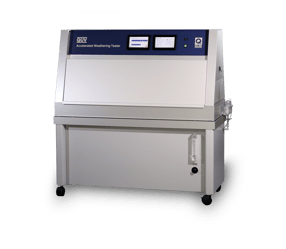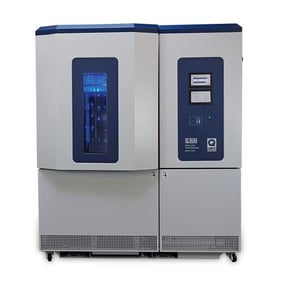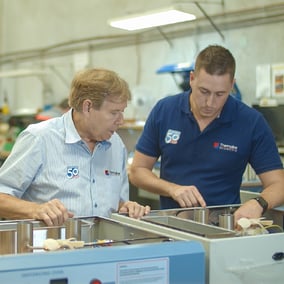
Corrosion/Weathering Test Cycle using a QUV and a Q-FOG.
ASTM D5894 is a test method developed by the American Society for Testing and Materials (ASTM) for conducting accelerated weathering and corrosion tests on painted or coated specimens. This test method is often used to evaluate the performance and durability of protective coatings and paints when exposed to harsh environmental conditions.
The ASTM B117, also known as 'salt fog' or 'salt spray', is a widely accepted industry standard for corrosion testing. However, some consider this standard outdated and prefer the ASTM D5894 test. The ASTM D5894 test is a cyclic corrosion test that incorporates both corrosion testing and UV exposure, which more closely resemble real-world field conditions. One of the reasons for this is that it was sound that ASTM B117 would show the differential in performance of surface coatings that would be observed in real-world applications.
This test (ASTM D5894) was developed based on the theory that a coating's ability to protect against corrosion reduces as it degrades from UV exposure. The new test combines the QUV weathering test methods (ASTM G154) with the prohesion method of cyclic accelerated corrosion testing (ASTM G85). This procedure is designed to test the combined corrosion and weathering resistance of coatings.
ASTM D5894 is a test used to replicate outdoor corrosion on painted metal. It simulates various environmental factors that occur simultaneously, such as corrosive environment, rain, alternating wet and dry conditions, temperature variations, and outdoor UV light (340nm). The aim of this test is to provide manufacturers with a more realistic and improved simulation compared to the static testing procedures under the testing in ASTM B117. In some cases, a deep cold cycle can be added to this test to extend its reach.
The corrosion/weathering cycle can often consist of one week of prohesion alternating with one week of QUV exposure. Typically, the test is continued for some 2000 hours. It's not possible to accurately measure the "time compression factor" when conducting accelerated aging tests, including those performed to ASTM D5894. Therefore, to establish a good time correlation, it is recommended to include control samples of products with known field performances for comparison. Additionally, the ASTM D5894 test can be adjusted to better simulate specific applications, such as by using different corrosive electrolyte formulations in ASTM G85.
One fog electrolyte solution used in this practice is only 0.5% in sodium chloride vs. 5% for the standard salt spray test. However, it also contains 0.35% ammonium sulphate, used to lower the pH of the solution to a range of 5 to 5.4 instead of 6.6 to 7 for salt spray testing.
Type of Samples:
ASTM D5894 is a test commonly referred to as the Cyclic Salt Fog/UV Exposure of Painted Metal. The fundamental principle behind this test is to subject samples to alternating exposures in a cabinet with fog and dry conditions and another cabinet with UV exposure and condensation. This practice is designed to be used specifically on painted metal samples. It involves alternating one-week periods of cyclic corrosion with a wet/dry cycle, which is based on the ASTM G85 test, Annex V, and a fluorescent UV exposure, which is based on the ASTM G154 test.
ASTM D5894 is useful for testing on air-dry maintenance paints on steel and zinc primers with cathodic protection.
Conclusion:
Keep in mind that combining weathering and corrosion testing may be complex and may require expertise in both areas. Financially, it will require two pieces of equipment. You may need to design your tests carefully to ensure that they accurately replicate the real-world conditions your materials will encounter. Additionally, consult with experts in materials science and testing to select the most appropriate standards and methods for your specific application.
If you have any questions at all or requirements for QUV or Q-FOG equipment, please contact our sales team for assistance.






